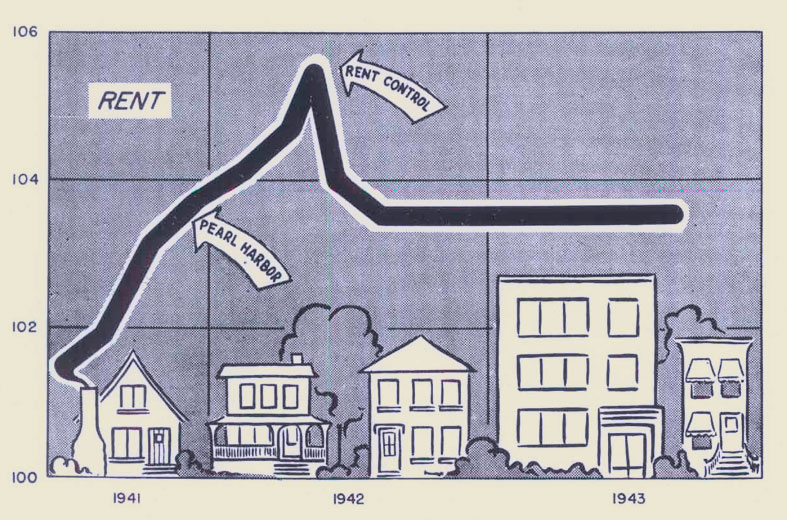"Share Your Home!"
 This elderly couple sits on the curb with all their possessions. The man holds a newspaper with the headline "Soaring Rents Evict Thousands." (Folder 8, Box 35, Defense Council, OSA)
This elderly couple sits on the curb with all their possessions. The man holds a newspaper with the headline "Soaring Rents Evict Thousands." (Folder 8, Box 35, Defense Council, OSA) Growing pains in cities with burgeoning defense industries led to a housing crisis in some areas of Oregon. Factories and shipyards built or expanded their facilities to accommodate huge war contracts and as a result attracted tens of thousands of workers to the state as part of what the National Housing Agency called an "epic migration." Some communities saw population decreases as people streamed out to join the military or take war production jobs elsewhere. But others, such as Hermiston, Medford and especially the Portland area, saw an overwhelming increase in residents from other parts of Oregon and from around the country. Some new residents worked in the factories running at full capacity around the clock. Others were family members of these workers or of the many soldiers stationed in places like Camp Adair. In response, officials used a number of strategies to increase the housing capacity of the affected communities. Measures such as building war worker housing, converting thousands of single family homes to accommodate two or more families, and imposing rent control all helped.
Government Slow to React
Unfortunately, the federal government reacted slowly to the housing shortage. Industry and labor leaders urged officials to build emergency housing and the government eventually responded. But they were limited by wartime material priorities that made it impossible to meet the civilian need "simply by unlimited construction of new houses." Federal authorities pointed out that materials such as lumber, steel, and copper that were needed to build houses were also needed for planes, ships, and tanks: "In the face of the tremendous demands of the war upon manpower and materials, there have not been enough of either to build new houses for all of the workers, let alone continue normal peacetime housing construction."
Footnote
1
 Tens of thousands of defense industry workers, such as those shown at Oregon Shipbuilding Corporation shipyards, streamed into the Portland area in need of housing. ("Record Breakers" Oregon Shipbuilding Corporation Promotional Booklet, Oregon State Library Holdings)
Tens of thousands of defense industry workers, such as those shown at Oregon Shipbuilding Corporation shipyards, streamed into the Portland area in need of housing. ("Record Breakers" Oregon Shipbuilding Corporation Promotional Booklet, Oregon State Library Holdings)
Instead of an outright building boom to meet demand, authorities tried to focus on the demand created only "by essential migration of war labor." The strategy also called for the use of the existing housing supply to the greatest extent possible, such as converting existing buildings into additional apartments, thereby limiting the use of vital materials. When new construction was essential, the strategy called for "drastic economies" in the use of critical war materials. This meant temporary war dwellings were constructed with up to 80% less critical materials than prewar standards. Permanent structures saw reductions of 60%-70%.
Footnote
2 Housing Projects Spring Up
During the war the federal government produced about two million dwelling units as homes for more than five million people. Many units were converted into apartments from existing buildings, but a sizeable amount resulted from new low-cost housing projects such as those constructed at Vanport. This sprawling community sprang up quickly on Portland's northern outskirts to provide housing for workers at the massive Kaiser Shipyards. With street after street of rental apartment houses, almost overnight the community became Oregon's second largest city as well as the largest war housing project in the world. It quickly reached and maintained its maximum tenancy of 40,000 people.
Footnote
3 One shipyard worker, Chauncey Del French, remembered Vanport in "its baby days" as decidedly unattractive: "Contractor's sheds, which housed offices, tools, supplies, and equipment, were scattered about the muddy streets that marked the entrance. The sidewalks were piled high with the debris of construction."
Footnote
4 A number of federal housing projects were built across the country in war production areas such as Arlington, Virginia, Wichita, Kansas and South Portland, Maine, most sharing the characteristic paper thin walls and shoddy build quality of housing designed from the start to be temporary. Still, some new residents saw the move into government housing as an improvement in their standard of living, and most were grateful for the opportunity.
"Share Your Home"
 A bird's eye view of part of Vanport, a massive housing project north of Portland that was home to 40,000 people. ("Record Breakers" Oregon Shipbuilding Corporation Promotional Booklet, Oregon State Library Holdings)
A bird's eye view of part of Vanport, a massive housing project north of Portland that was home to 40,000 people. ("Record Breakers" Oregon Shipbuilding Corporation Promotional Booklet, Oregon State Library Holdings) Authorities knew they didn't have the resources to solve the housing shortage with projects such as Vanport, so the National Housing Agency launched a campaign titled "Share Your Home." As part of the campaign, authorities offered encouragement and inducements to families to "move over" and make room for the influx of migrants. Some of the effort involved conducting surveys to "make as careful an analysis of the existing or potential supply of housing as is possible and to encourage the use of all existing housing facilities and the sharing of homes in order to reduce as much as possible the amount of additional housing needed." Canvassers spread out over the Eugene and Springfield area in October 1943 after officials expressed the urgency of the need: "Due to the present pressure that is being exerted for obtaining housing relief in the Eugene-Springfield area, it is highly desirable that we obtain a housing survey at the earliest possible moment." The questionnaire gathered information about the condition, furnishings, number of bedrooms, and presence of an inside toilet for vacant housing in the area. It documented data about occupied housing that had space available, including the number of male and female sleeping rooms, the number of housekeeping units with one, two, or three bedrooms, and whether or not remodeling was needed.
Footnote
5 Portland Efforts
 Hundreds of stately old Portland homes, such as this one in the Irvington neighborhood, were divided into apartments during the war to accommodate the growing population. (WW2 Web Exhibit Records, OSA)
Hundreds of stately old Portland homes, such as this one in the Irvington neighborhood, were divided into apartments during the war to accommodate the growing population. (WW2 Web Exhibit Records, OSA) Portlanders in particular were pressed to share their homes. Appealing to the patriotism of homeowners, officials blamed rising absenteeism at least partially on the lack of housing: "Many workers coming into this section for essential war jobs take almost any kind of accommodations they can find on what they expect to be a temporary basis. But with the critical shortage of housing here, it is almost impossible for these workers to find adequate quarters in their spare time, so the men continue to take a day or two off to hunt for decent housing, until they either are successful, or give up in disgust, quit their jobs and take their families elsewhere." More housing options, it was argued, would reduce the absenteeism and increase production for the war.
Footnote
6
Officials also applied guilt to the owners of Portland's numerous stately and very large homes built in the early decades of the 1900s: "Many of the larger homes here, now only in partial use, should be thrown open to these workers." While recognizing the reluctance of some families to accept paying guests in their homes, authorities chided that "this is not the time to indulge in personal tastes, when successful prosecution of the war, including vital production, is every citizen's responsibility." The welfare of children also played a role in the appeal: "If owners of some large old homes here would permit conversion of their property for use as apartments, and if others would take a war worker family into their homes as war guests, the children would have the benefit of large yards and nearby playgrounds."
Footnote
7
Governments offered inducements beyond patriotism and relief from guilt to get residents to convert their large homes to apartments. The manager of the Portland war housing center pointed out that loans were available and that homeowners would qualify for a priority to obtain the materials needed to complete the conversion to apartments. Moreover, a steady stream of rent would come to those who provided much needed apartment space.
Footnote
8
Relaxed Building Codes Encourage Conversion
 The City of Portland relaxed building codes during the war to allow smaller kitchens and living rooms. City leaders hoped this move and others like it would lead owners of large homes to divide them into apartments for the thousands of defense workers moving to the city. Hundreds of homes were converted, providing a valuable contribution to the community. (Box 4 of 28, Education Dept. Records, OSA)
The City of Portland relaxed building codes during the war to allow smaller kitchens and living rooms. City leaders hoped this move and others like it would lead owners of large homes to divide them into apartments for the thousands of defense workers moving to the city. Hundreds of homes were converted, providing a valuable contribution to the community. (Box 4 of 28, Education Dept. Records, OSA) The City of Portland, like other defense industry cities, relaxed building codes to help spur the conversion of its larger homes to additional living space. In making the change, City Commissioner William Bowes hoped several thousand homes would provide at least one extra living unit. Of course, the devil was in the details since the ordinance contained the requisite amount of bureaucratic language. One catch was that the city planned to have the new regulations in effect only for the duration of the war. At that point, city leaders said that "the altered building must be changed back to its original occupancy or altered to conform to the housing code regulations." Those who chose to move forward with conversions found features such as sinks and toilets, which normally would be required for each housing unit, were now only required to be "accessible" to each housing unit. Other relaxations included allowing smaller kitchens and living rooms than before, although bedroom size restrictions remained unchanged.
 City of Portland Housing Code OrdinanceFootnote
9
City of Portland Housing Code OrdinanceFootnote
9 Rent Control
Regulations also controlled rent in several Oregon counties, since having enough housing units would be of little value if few people could afford to rent them. High rents in war production cities such as Portland led to problems with maintaining a stable workforce and optimum production for the war effort. In the process, landlords were seeing big profits. One study of 40,000 housing units in 20 large defense industry cities showed that from 1939 to 1942 the operating income jumped 31% for an average apartment house unit and 45% for an average small structure. In response, the federal Emergency Price Control Act of 1942 gave the Office of Price Administration (OPA) authority to designate "defense-rental areas" throughout the country "where defense activities have resulted or threaten to result in an increase in rents for housing accommodations...." By 1943 the OPA had designated 370 rent control areas regulating some 11 million rented homes as well as 350,000 hotels and rooming houses. In Oregon these areas centered around activities in Astoria, Corvallis, Medford, Pendleton and the Portland-Vancouver metro area.
Footnote
10
 This graph shows the stabilizing effect of rent control in key defense activity areas such as Portland and Astoria. (Folder 8, Box 35, Defense Council, OSA)
This graph shows the stabilizing effect of rent control in key defense activity areas such as Portland and Astoria. (Folder 8, Box 35, Defense Council, OSA)
The OPA set up an "area rent office" in each defense-rental area to administer the new regulations. The most important provision was to freeze or roll back rents to a "base" date. In the case of the Portland-Vancouver area, the date was March, 1 1942. As officials at the local area rent office pointed out, the process was straightforward: "A tenant does not have to get approval from the rent director or anybody else. He simply reduces his own rent to the March 1, 1942 rent." Anticipating the need to keep landlords honest, the regulations required landlords to file registration statements with the local area rent office, including rent and other "basic facts" about each apartment. These statements were to be given to each tenant too. Tenants were told they "should receive the same essential services [such as heat, water, etc.] as are listed in the registration statement...," and they were encouraged to report discrepancies to the area rent office. Landlords were allowed to petition for the right to reduce services or increase rents "where special circumstances justify" and they could repossess an apartment to do extensive remodeling or to occupy the unit themselves.
Footnote
11Housing Problems Nationally and Locally
 Mobile homes became homes for millions of people during the war, as they moved to communities without adequate housing. (Image courtesy Library of Congress)
Mobile homes became homes for millions of people during the war, as they moved to communities without adequate housing. (Image courtesy Library of Congress) Despite efforts to provide affordable housing for people working in war production industries, deplorable conditions and abuses persisted nationwide. Congressional hearings heard tales of two families with a total of 12 people sleeping in one room. The occupants slept in shifts as a witness testified: "They don't all sleep at the same time--it's a 'hot bed' up there." Children often suffered the most as landlords sometimes evicted families and replaced them with individual renters who, added together, paid more rent. Newspapers often contained classified advertisements for apartments that included the stipulation "adults only." One witness told a Congressional committee that "when I mention children they [landlords] don't talk to me anymore." The committee chairman observed that "it used to be an honor to have a large family, but now it seems to be a handicap."
Footnote
12
"The enlisted men and officers to be stationed at Camp Adair for the duration of the war to train men going to the Pacific are now coming into town and are very anxious to find housing for their families. These men, most of whom have served overseas for some time, are desirous of having their families with them, inasmuch as this will be the first opportunity for many to have a home life. "Footnote
14
Oregon experienced housing problems around military bases such as Camp Adair. Officials with the Marion County Defense Council scrambled to find sleeping quarters for servicemen on leave from nearby Camp Adair. One weekend in February 1943 there were "approximately five hundred men in Salem who could not find any accommodations for staying over night. As a result, they were forced to stay in bus and railroad waiting rooms and such other places as were available." An official with the Federal Security Agency told the Salem mayor the only solution he could see was to "put in a curfew law which would automatically make the soldiers return [to Camp Adair] at a given hour." The mayor, likely reluctant to send soldiers with money in their pockets out of town, instead proposed repairs and changes to the USO (United Service Organizations) building in Salem. Related efforts added 120 beds for soldiers at St. Joseph's Church and 80 beds at the YMCA, both in Salem.
 Correspondence: Roger Folgate and Brian ConleyFootnote
13
Correspondence: Roger Folgate and Brian ConleyFootnote
13
While these efforts added accommodations for soldiers, another round of problems arose in July 1945 after victory in Europe as soldiers streamed west to fight the Japanese in the Pacific. Saying they were "very concerned over the present situation," Marion County Defense Council officials sent an "urgent" plea for any vacancies in apartments or homes to meet the influx. Hazel Harper, the block leader chief for the council, described the reason for the housing crunch: "The enlisted men and officers to be stationed at Camp Adair for the duration of the war to train men going to the Pacific are now coming into town and are very anxious to find housing for their families. These men, most of whom have served overseas for some time, are desirous of having their families with them, inasmuch as this will be the first opportunity for many to have a home life. "
Footnote
14